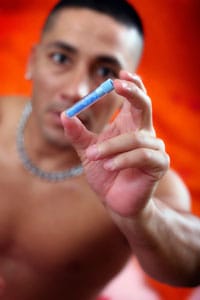Among the men and women who abuse cocaine, crystal methamphetamine, and other “party” drugs (Ketamine, GHB, MDMA, etc.) there is a large and rapidly growing subgroup for whom drug abuse and problematic sexual behavior only occur together. The two behaviors are so tightly paired that engaging in one inevitably means engaging in the other. For these individuals, “stimulants and sex” are a single addiction with interrelated, co-existing, complementary behaviors, rather than two separate issues. To achieve lasting sobriety, these fused behaviors need to be treated simultaneously in an integrated program of recovery. Treating one without also addressing the other is futile. Until recently, however, there were no rehabilitation facilities comprehensively treating stimulant use fused with problematic sexual behavior. Individuals with this “double addiction” typically entered treatment for cocaine or crystal meth abuse, either dismissing their sexual acting out entirely or writing it off as something that “only happens when I’m using.” And even if the client didn’t view his or her sexual behavior in this fashion, the staff usually would (because they weren’t trained to deal with the sexual issues). So these clients, individuals with an extensive history of abusing drugs and sex simultaneously, ended up being treated for only half their problem. Their shame and secrets regarding past sexual behavior were left unaddressed in drug and alcohol treatment, as was the need for education about how to safely handle sexual activity in sobriety. Many of these people left substance abuse treatment without even realizing there was a whole other set of issues that needed to be dealt with. Not surprisingly, most stimulant/sex addicts have a history of chronic relapse. Oftentimes they have repeatedly tried and failed to get clean from cocaine, crystal meth, and other party drugs – with all of their relapses directly or indirectly related to their sexual behavior. Basically, these addicts stop using stimulants, but they still want the thrilling, super-intense sex they used to have while using, so they return to the same people and places for sex. This presents two glaring issues: 1) the sex “isn’t as good” without the drugs; and 2) this is where the drugs are. Before the addict knows it, he’s using again. The simple, undeniable fact is the most difficult substances to recover and stay sober from are cocaine and crystal meth, and when the allure of sexual intensity is added to that – triggering it, intertwined with it – the problem is magnified exponentially. Somewhat amazingly, the newly opened Stimulant and Sexual Disorders Program (SSDP) at Promises, Malibu is the first facility to develop specific treatment methods – both psychological and medical – addressing the unique needs of this double-trouble population. The six-bed, males only program has a customized curriculum specifically designed to meet the needs of men – straight, gay, and everything in-between – whose stimulant abuse and problematic sexual behaviors are fused so tightly that treating one addiction without also treating the other is pointless. One typical SSDP client is the heterosexual male who rents a hotel room, binges on cocaine, and hires prostitutes or brings in anonymous sex partners he meets online. Another typical client is a homosexual man who abuses crystal meth and has sex for hours or even days at a time in bathhouses and sex clubs or with men he picks up using sex locator smartphone apps like Grindr. There are also men of both sexual orientations who isolate with cocaine or crystal meth and compulsively masturbate to pornography and/or hire prostitutes. Of course there are many other variations to stimulant/sex addiction, but the basic scenario of a problem that fuses drug addiction and problematic sexual behavior is the common denominator. In addition to traditional cognitive behavioral and 12-step type approaches typically seen in substance abuse treatment programs, the newly opened SSDP integrates much needed medical and neurobiological components designed to help clients deal with the urges and cravings that so often lead to stimulant/sex addiction relapse. To that end the program prescribes, when appropriate, certain well-researched medications that can reduce the urge to use and/or sexually act out during the critical, early months of recovery. The program also incorporates state-of-the art cognitive training modules that can also reduce impulsivity and cravings. Furthermore, the issue of how clients can approach healthy sexuality is incorporated into the curriculum as a significant and incredibly necessary relapse prevention focus. In essence, the SSDP provides a more integrated, holistic view of the stimulant/sex addict’s mind and body than currently exists anywhere else.

